
Mortellaro's Nursery
Shrubs, trees, ground covers, native plants, and seasonal color
Wholesale Only
Click on any of the alpha indexes below to view the corresponding lists of plants.
The default list is displayed alphabetically by common name for all plant types. You can view the plants by clicking on the Scientific Name or limit the plant type by using the drop down.
Plants actively being grown for the current season are shown -- selecting Discontinued Items will show plants we have offered in the past.
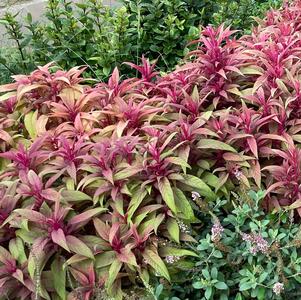
|
Celosia Dragon's BreathBotanical Name: Celosia argentea 'Dragons Breath®'
Celosia 'Dragon's Breath' is a striking annual plant renowned for its fiery foliage and unique appearance, making a bold statement in garden landscapes. Its vibrant, flame-colored plumes rise above lush green foliage, creating a captivating display of color and texture. 'Dragon's Breath' stands out for its compact growth habit, making it suitable for borders, containers, or mass plantings. This heat-tolerant and drought-resistant cultivar thrives in sunny locations with well-drained soil, providing a burst of color throughout the summer months. Its resilience and eye-catching aesthetics make it a popular choice for landscape designers and gardeners seeking to infuse their outdoor spaces with drama and intensity. [ More Info ]
|
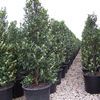
|
Cherry Laurel, CompactBotanical Name: Prunus caroliniana 'Compacta'
The Cherry Laurel species is native to East Texas where it thrives with the regular rainfall and acidic soils. It tolerates heat, drought, and wind so well, that it is utilized nearly anywhere Texas. ‘Compacta’ is a cultivar with more compact growth habit, smaller leaf size, and a maturing at half the size of the regular Cherry Laurel. The small bright-green leaves have the odor of maraschino cherries when crushed, and are toxic. Fragrant white flowers cover the branches in the early spring, easily attracting butterflies and bees. They are followed by small black cherry fruits that only wildlife can enjoy, as they are poisonous to us as well. Compact Cherry Laurel responds well to pruning, and often is sheared into cone shapes to keep its compact form. [ More Info ]
|

|
Chili PequinBotanical Name: Capsicum annumm 'pequin'
Chili pepper plant is a very productive semi-compact pepper plant with open free growth habit. Tiny peppers are enjoyed by birds leading it to be sprouting up all over the yard after a few years. [ More Info ]
|
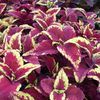
|
Coleus, MixedBotanical Name: Coleus x
Popular fast growing bedding plant for the summer that does best in filtered to full shade. Attractive foliage is opposite and simple, ovate leaves. Come in shades of yellow, dull red, purple, and pale green. Flowers are dark blue to cream, displayed in terminal spike-like racemes that reach three inches long. Coleus needs loose, well drained fertile soil, and does well as an underplanting. Mealy bugs are a problem when grown in full shade, and frequent trimming will ensure a thick bushy plant. 2010 Spring - Summer Cultivars : Burgundy Sun [ More Info ]
|
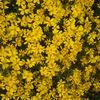
|
Copper Canyon DaisyBotanical Name: Tagetes lemmonii
Bushy perennial that heavily covers itself with yellow daisy-like blooms in the spring and fall, and intermittently during the summer. Great tolerance to hot and dry areas. Grows up to six feet tall and four feet wide, but can get weedy-looking and will recover quickly from pruning in the warm seasons. Foliage has a bitter aroma. [ More Info ]
|
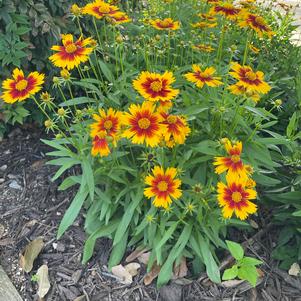
|
CoreopsisBotanical Name: Coreopsis UPTICK Gold & Bronze 'Baluptred'
Coreopsis Uptick Gold & Bronze is a delightful plant that is prized for its vibrant and showy blooms. The Uptick Gold & Bronze variety of Coreopsis has a compact and upright habit that grows up to 12-18 inches tall and spreads up to 12-16 inches wide. The leaves are lance-shaped and have a bright green color that forms a dense, bushy mound. The foliage is attractive even when the plant is not in bloom. The flowers of Coreopsis Uptick Gold & Bronze are the main attraction. They bloom profusely from early summer until fall, producing clusters of bright golden-yellow flowers with a bronze-red center. The flowers are 1-2 inches wide and have a distinctive daisy-like appearance. They are held atop sturdy stems that are well-suited to cutting for use in floral arrangements. Coreopsis Uptick Gold & Bronze is an easy-to-grow plant that thrives in full sun to partial shade and well-draining soil. It is drought-tolerant and can withstand some humidity. The plant is relatively low-maintenance and does not require much pruning or fertilization. Deadheading spent blooms will encourage continuous blooming throughout the growing season. [ More Info ]
|
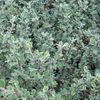
|
Cotoneaster, GrayleafBotanical Name: Cotoneaster glaucophyllus
Often mispronounced as the two separate words Coton and Easter, Cotoneaster is one of the more durable and hardy landscape shrubs for the Texas landscape. It tolerates urban conditions, poor soils, and even drought – but thrives when given favorable care. It has an appealing shade of gray-green foliage that is slightly pubescent, arranged on low arching branches that somewhat form a thicket. The small leaves and compact form allow to be pruned into thick hedges easily. Clusters of small white flowers appear on the branches throughout the spring, and are followed by red berries that persist throughout the fall. [ More Info ]
|

|
Crape Myrtle, BashamBotanical Name: Lagerstroemia indica 'Basham'
Lagerstroemia is a genus with over 50 species and numerous cultivars to offer trees, shrubs, and weeping shrubs that can be utilized for just about any purpose in the landscape. Crape Myrtles are primarily grown for their long-lasting blooms – up to 120 days! Most species also have a smooth bark that sheds thin layers throughout the year, uncovering inner bark that is shades of gray or even cinnamon-red. 'Basham' is a large growing cultivar with light pink blooms; it is a powdery mildew resistant cultivar. Flowers begin to emerge in the early summer after foliage, in panicles of crinkled small flowers with a crepe-like feel and look. They last longer if the plant is not terribly overwatered. When the blooms finally being to drop, they are followed by a large number of capsule fruits that can weigh down the branches. If it’s still early in the ear, prune the fruits to promote another round of flowering. If untrimmed, the large green fruits will dry out, turning into black husk that split open to release numerous small seeds. Blooms only appear on new branches, so it’s not uncommon to prune them in the winter. Unfortunately, larger specimens are often butchered back severely to encourage additional branches and many more blooms. Since most crape myrtles recover nicely, they are routinely victimized by those without taste. Simple opposite green leaves emerge early in the spring, and vary in size according to the cultivar. They turn a lovely shade of red, orange, or yellow in the fall. Crape Myrtles appreciate moist soils, but tolerate dry conditions once they are established.
[ More Info ]
|

|
Crape Myrtle, DynamiteBotanical Name: Lagerstroemia indica 'Dynamite'
Lagerstroemia is a genus with over 50 species and numerous cultivars to offer trees, shrubs, and weeping shrubs that can be utilized for just about any purpose in the landscape. Crape Myrtles are primarily grown for their long-lasting blooms – up to 120 days! Most species also have a smooth bark that sheds thin layers throughout the year, uncovering inner bark that is shades of gray or even cinnamon-red. Flowers begin to emerge in the early summer after foliage, in panicles of crinkled small flowers with a crepe-like feel and look. They last longer if the plant is not terribly overwatered. When the blooms finally being to drop, they are followed by a large number of capsule fruits that can weigh down the branches. If it’s still early in the ear, prune the fruits to promote another round of flowering. If untrimmed, the large green fruits will dry out, turning into black husk that split open to release numerous small seeds. Blooms only appear on new branches, so it’s not uncommon to prune them in the winter. Unfortunately, larger specimens are often butchered back severely to encourage additional branches and many more blooms. Since most crape myrtles recover nicely, they are routinely victimized by those without taste. Simple opposite green leaves emerge early in the spring, and vary in size according to the cultivar. They turn a lovely shade of red, orange, or yellow in the fall. Crape Myrtles appreciate moist soils, but tolerate dry conditions once they are established. [ More Info ]
|
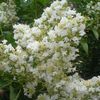
|
Crape Myrtle, NatchezBotanical Name: Lagerstroemia indica 'Natchez'
Lagerstroemia is a genus with over 50 species and numerous cultivars to offer trees, shrubs, and weeping shrubs that can be utilized for just about any purpose in the landscape. Crape Myrtles are primarily grown for their long-lasting blooms – up to 120 days! Most species also have a smooth bark that sheds thin layers throughout the year, uncovering inner bark that is shades of gray or even cinnamon-red. 'Natchez' is a large cultivar, one of the largest available, with bright white blooms. Flowers begin to emerge in the early summer after foliage, in panicles of crinkled small flowers with a crepe-like feel and look. They last longer if the plant is not terribly overwatered. When the blooms finally being to drop, they are followed by a large number of capsule fruits that can weigh down the branches. If it’s still early in the ear, prune the fruits to promote another round of flowering. If untrimmed, the large green fruits will dry out, turning into black husk that split open to release numerous small seeds. Blooms only appear on new branches, so it’s not uncommon to prune them in the winter. Unfortunately, larger specimens are often butchered back severely to encourage additional branches and many more blooms. Since most crape myrtles recover nicely, they are routinely victimized by those without taste. Simple opposite green leaves emerge early in the spring, and vary in size according to the cultivar. They turn a lovely shade of red, orange, or yellow in the fall. Crape Myrtles appreciate moist soils, but tolerate dry conditions once they are established. [ More Info ]
|

|
Crape Myrtle, Pink VelourBotanical Name: Lagerstroemia indica 'Pink Velour'
Lagerstroemia is a genus with over 50 species and numerous cultivars to offer trees, shrubs, and weeping shrubs that can be utilized for just about any purpose in the landscape. Crape Myrtles are primarily grown for their long-lasting blooms – up to 120 days! Most species also have a smooth bark that sheds thin layers throughout the year, uncovering inner bark that is shades of gray or even cinnamon-red. Pink Velour has burgundy-green leaves that get dark red-bronze in the fall, with pink blooms. Powdery Mildew resistant cultivar. Flowers begin to emerge in the early summer after foliage, in panicles of crinkled small flowers with a crepe-like feel and look. They last longer if the plant is not terribly overwatered. When the blooms finally being to drop, they are followed by a large number of capsule fruits that can weigh down the branches. If it’s still early in the ear, prune the fruits to promote another round of flowering. If untrimmed, the large green fruits will dry out, turning into black husk that split open to release numerous small seeds. Blooms only appear on new branches, so it’s not uncommon to prune them in the winter. Unfortunately, larger specimens are often butchered back severely to encourage additional branches and many more blooms. Since most crape myrtles recover nicely, they are routinely victimized by those without taste. Simple opposite green leaves emerge early in the spring, and vary in size according to the cultivar. They turn a lovely shade of red, orange, or yellow in the fall. Crape Myrtles appreciate moist soils, but tolerate dry conditions once they are established. [ More Info ]
|

|
Crape Myrtle, PurpleBotanical Name: Lagerstroemia indica
Lagerstroemia is a genus with over 50 species and numerous cultivars to offer trees, shrubs, and weeping shrubs that can be utilized for just about any purpose in the landscape. Crape Myrtles are primarily grown for their long-lasting blooms – up to 120 days! Most species also have a smooth bark that sheds thin layers throughout the year, uncovering inner bark that is shades of gray or even cinnamon-red. 'Catawba' is a medium sized tree, with a fine rich purple bloom color. Flowers begin to emerge in the early summer after foliage, in panicles of crinkled small flowers with a crepe-like feel and look. They last longer if the plant is not terribly overwatered. When the blooms finally being to drop, they are followed by a large number of capsule fruits that can weigh down the branches. If it’s still early in the ear, prune the fruits to promote another round of flowering. If untrimmed, the large green fruits will dry out, turning into black husk that split open to release numerous small seeds. Blooms only appear on new branches, so it’s not uncommon to prune them in the winter. Unfortunately, larger specimens are often butchered back severely to encourage additional branches and many more blooms. Since most crape myrtles recover nicely, they are routinely victimized by those without taste. Simple opposite green leaves emerge early in the spring, and vary in size according to the cultivar. They turn a lovely shade of red, orange, or yellow in the fall. Crape Myrtles appreciate moist soils, but tolerate dry conditions once they are established.
[ More Info ]
|
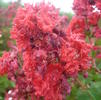
|
Crape Myrtle, RedBotanical Name: Lagerstroemia indica
Lagerstroemia is a genus with over 50 species and numerous cultivars to offer trees, shrubs, and weeping shrubs that can be utilized for just about any purpose in the landscape. Crape Myrtles are primarily grown for their long-lasting blooms – up to 120 days! Most species also have a smooth bark that sheds thin layers throughout the year, uncovering inner bark that is shades of gray or even cinnamon-red. Flowers begin to emerge in the early summer after foliage, in panicles of crinkled small flowers with a crepe-like feel and look. They last longer if the plant is not terribly overwatered. When the blooms finally being to drop, they are followed by a large number of capsule fruits that can weigh down the branches. If it’s still early in the ear, prune the fruits to promote another round of flowering. If untrimmed, the large green fruits will dry out, turning into black husk that split open to release numerous small seeds. Blooms only appear on new branches, so it’s not uncommon to prune them in the winter. Unfortunately, larger specimens are often butchered back severely to encourage additional branches and many more blooms. Since most crape myrtles recover nicely, they are routinely victimized by those without taste. Simple opposite green leaves emerge early in the spring, and vary in size according to the cultivar. They turn a lovely shade of red, orange, or yellow in the fall. Crape Myrtles appreciate moist soils, but tolerate dry conditions once they are established.
[ More Info ]
|
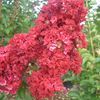
|
Crape Myrtle, Red RocketBotanical Name: Lagerstroemia indica 'Red Rocket'
Lagerstroemia is a genus with over 50 species and numerous cultivars to offer trees, shrubs, and weeping shrubs that can be utilized for just about any purpose in the landscape. Crape Myrtles are primarily grown for their long-lasting blooms – up to 120 days! Most species also have a smooth bark that sheds thin layers throughout the year, uncovering inner bark that is shades of gray or even cinnamon-red. 'Red Rocket' is an improved powdery mildew resistance cultivar with rich red blooms. Flowers begin to emerge in the early summer after foliage, in panicles of crinkled small flowers with a crepe-like feel and look. They last longer if the plant is not terribly overwatered. When the blooms finally being to drop, they are followed by a large number of capsule fruits that can weigh down the branches. If it’s still early in the ear, prune the fruits to promote another round of flowering. If untrimmed, the large green fruits will dry out, turning into black husk that split open to release numerous small seeds. Blooms only appear on new branches, so it’s not uncommon to prune them in the winter. Unfortunately, larger specimens are often butchered back severely to encourage additional branches and many more blooms. Since most crape myrtles recover nicely, they are routinely victimized by those without taste. Simple opposite green leaves emerge early in the spring, and vary in size according to the cultivar. They turn a lovely shade of red, orange, or yellow in the fall. Crape Myrtles appreciate moist soils, but tolerate dry conditions once they are established. [ More Info ]
|
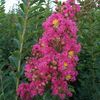
|
Crape Myrtle, TuscaroraBotanical Name: Lagerstroemia indica 'Tuscarora'
Lagerstroemia is a genus with over 50 species and numerous cultivars to offer trees, shrubs, and weeping shrubs that can be utilized for just about any purpose in the landscape. Crape Myrtles are primarily grown for their long-lasting blooms – up to 120 days! Most species also have a smooth bark that sheds thin layers throughout the year, uncovering inner bark that is shades of gray or even cinnamon-red. 'Tuscarora' is an improved powdery mildew resistance cultivar with light red blooms, often used in leu of Watermelon Red. Flowers begin to emerge in the early summer after foliage, in panicles of crinkled small flowers with a crepe-like feel and look. They last longer if the plant is not terribly overwatered. When the blooms finally being to drop, they are followed by a large number of capsule fruits that can weigh down the branches. If it’s still early in the ear, prune the fruits to promote another round of flowering. If untrimmed, the large green fruits will dry out, turning into black husk that split open to release numerous small seeds. Blooms only appear on new branches, so it’s not uncommon to prune them in the winter. Unfortunately, larger specimens are often butchered back severely to encourage additional branches and many more blooms. Since most crape myrtles recover nicely, they are routinely victimized by those without taste. Simple opposite green leaves emerge early in the spring, and vary in size according to the cultivar. They turn a lovely shade of red, orange, or yellow in the fall. Crape Myrtles appreciate moist soils, but tolerate dry conditions once they are established. [ More Info ]
|
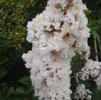
|
Crape Myrtle, WhiteBotanical Name: Lagerstroemia indica
Lagerstroemia is a genus with over 50 species and numerous cultivars to offer trees, shrubs, and weeping shrubs that can be utilized for just about any purpose in the landscape. Crape Myrtles are primarily grown for their long-lasting blooms – up to 120 days! Most species also have a smooth bark that sheds thin layers throughout the year, uncovering inner bark that is shades of gray or even cinnamon-red. Flowers begin to emerge in the early summer after foliage, in panicles of crinkled small flowers with a crepe-like feel and look. They last longer if the plant is not terribly overwatered. When the blooms finally being to drop, they are followed by a large number of capsule fruits that can weigh down the branches. If it’s still early in the ear, prune the fruits to promote another round of flowering. If untrimmed, the large green fruits will dry out, turning into black husk that split open to release numerous small seeds. Blooms only appear on new branches, so it’s not uncommon to prune them in the winter. Unfortunately, larger specimens are often butchered back severely to encourage additional branches and many more blooms. Since most crape myrtles recover nicely, they are routinely victimized by those without taste. Simple opposite green leaves emerge early in the spring, and vary in size according to the cultivar. They turn a lovely shade of red, orange, or yellow in the fall. Crape Myrtles appreciate moist soils, but tolerate dry conditions once they are established.
[ More Info ]
|

|
CrossvineBotanical Name: Bignonia capreolata 'Tangerine Beauty'
A Texas native semi-evergreen vine that climbs fences, trellises, and trees easily with its small tendrils. It can reach lengths up to 40 feet, easily attracting hummingbirds and butterflies throughout the blooming season. 'Tangerine Beauty' is a cultivar reintroduced by J.C. Ralston of the University of North Carolina. The flowers are borne in clusters, each being pinkish-red with an orange-yellow throat. The bright green leaves turn an attractive red to purple hue in the winter after the first cold front. . Crossvine is somewhat drought and poor soil tolerant, exhibiting no pest issues. [ More Info ]
|

|
Cuphea, Bat FaceBotanical Name: Cuphea llavea
Small mounding perennial native to Mexico that attracts hummingbirds and butterflies easily. Produces a multitude of 1" red tubular flowers with purple throats open at the end with small patterns of a bat (hence the name) [ More Info ]
|
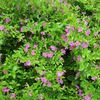
|
Cuphea, Dwarf Mexican HeatherBotanical Name: Cuphea hyssopifolia
Quick growing Mexican native perennial that reaches only twelve inches tall and wide returning in the spring if mulched heavily. Small attractive purple flowers appear in the early summer that stay till winter. Attracts bees and butterflies easily. [ More Info ]
|
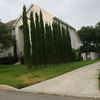
|
Cypress, ItalianBotanical Name: Cupressus sempervirens
A species of cypress that is native to the Mediterranean which distinctively stands out with its very tall and narrow growth habit. It requires unique placement in any landscape, getting no more than a few feet wide yet up to 40 feet tall. The erect branches do not branch far out from the main trunk, and have scale-like leaves produced off shoots of the branches. The dense, dark green leaves hold their color year round; in colder climates to the north the tree forms a narrow cone-shape. The seed cones are not readily visible when mixed in with the leaves. Requires well drained soils, and appreciates regular watering and fertilization. [ More Info ]
|
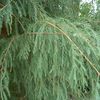
|
Cypress, MontezumaBotanical Name: Taxodium mucronatum
Native to Mexico and the Rio Grande area of Texas, Montezuma Cypress is also known as Sabino or Ahuehuete; it is the national tree of Mexico. There is a specimen called “Tule” in Santa Maria that is estimated to be 2,000 years old. Montezuma Cypress tree is an ideal substitute for the Bald Cypress, as it holds onto its leaves better during cold weather. In warmer areas of Southern Texas, it remains evergreen. Extremely versatile as it thrives in river beds and standing water, it tolerates drought like conditions anywhere in Texas. When grown in standing water, it produces “knees” that are characteristic of the Taxodium cypresses. They are often staked when cultivated in the nursery industry, as they are fast growing and the wood is weak when young. The branches have a natural weeping habit to them, and have pinnately arranged flat leaves that are needle-like, looking very delicate from a distance. The tree forms a broad spreading crown. The bark is brown to tan in color, with slight shredded-like exfoliation. [ More Info ]
|
